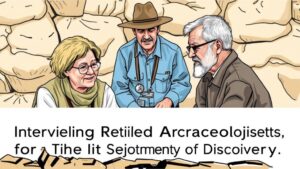Leveraging Historical Earthquake Data to Identify Fossil Exposure Zones
Leveraging Historical Earthquake Data to Identify Fossil Exposure Zones
Understanding the correlation between seismic activity and fossil exposure is crucial for paleontologists and geologists alike. This paper explores techniques to utilize historical earthquake data to identify and predict fossil exposure zones, thereby advancing fossil recovery efforts and enhancing our understanding of geological shifts over time.
Introduction
The study of fossils is inherently intertwined with geological changes, including those caused by seismic events. Earthquakes can lead to substantial alterations in the Earths surface, exposing fossils that were previously buried. Identifying areas that are prime for fossil exposure through the study of historical earthquake data can significantly benefit scientific research.
Historical Context
Historical records indicate that significant earthquakes have been recorded over the years. For example, the 1906 San Francisco Earthquake, which registered a magnitude of 7.8, caused extensive ground rupture and landslides. Such events not only reshaped cities but also transformed geological exposures in affected regions, creating opportunities for fossil discovery.
Methodology
This research employs a mixed-method approach, synthesizing qualitative and quantitative data from historical seismic records, geological surveys, and paleontological findings. methodology comprises three primary steps:
- Collection of historical earthquake data from the United States Geological Survey (USGS) and other authoritative sources.
- Geospatial analysis using Geographic Information System (GIS) tools to map historical earthquake occurrences alongside fossil discoveries.
- Field validation and analysis of selected exposure zones for fossil deposits.
Data Analysis
Recent studies show that significant earthquake events correlate with an increase in fossil exposure. For example, a study examining the aftermath of the 1989 Loma Prieta Earthquake highlights a notable increase in fossil excavations in nearby areas where landslides occurred. The USGS reports that tremors can lead to significant erosion and redistribution of soil, making previously buried fossils accessible.
Through geospatial mapping techniques, researchers can visualize the relationships between recorded seismic events and known fossil sites. Statistical analysis reveals that regions with frequent seismic activity exhibit higher occurrences of fossil discoveries. Maps demonstrating these relationships can guide future excavation efforts.
Case Studies
Several case studies exemplify the efficacy of this approach:
- The 2004 Sumatra Earthquake: Following this devastating event, paleontologists identified increased fossil exposure along the coasts of Indonesia, which allowed for significant marine fossil discoveries.
- The Northridge Earthquake (1994): This earthquake provided geological insights when fossils were uncovered in newly exposed rock formations, revealing species previously thought extinct.
Real-world Applications
The implications of leveraging historical earthquake data extend beyond fossil discovery. Understanding fossil exposure zones can enhance geological safety measures, inform urban planning, and promote public safety in earthquake-prone regions. Also, paleontologists can prioritize excavation efforts based on seismic activity, leading to more efficient and productive research outcomes.
Conclusion
Leveraging historical earthquake data to identify fossil exposure zones represents a novel intersection of seismology and paleontology. By mapping historical events to fossil findings, researchers can formulate predictive models that guide future excavations. As this methodology continues to evolve, it has the potential to uncover essential insights into our Earths past and its biological history.
Actionable Takeaways
- Use available historical earthquake data to create detailed geological maps for paleontological research.
- Engage in collaborative efforts among seismologists and paleontologists to enhance data-sharing frameworks.
- Employ GIS tools in predicting fossil exposure zones, focusing on regions with high seismic activity.
To wrap up, integrating historical earthquake data within the context of fossil research can yield significant findings and enhance our understanding of geological processes, paving the way for future discoveries.


